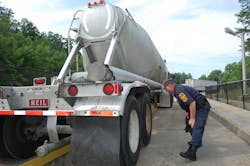ATRI: How states enforce rules can damage CSA scores
The disparate enforcement of commercial motor-vehicle (CMV) safety rules at the state level creates “uneven safety playing fields” for motor carriers, contends the American Transportation Research Institute (ATRI).
Per the nonprofit research organization, that contention is borne out by the “landmark analysis” within its newly released study “Evaluating the Impact of Commercial Motor Vehicle Enforcement Disparities on Carrier Safety Performance.”
The 100-pg study examined the impact of the varying enforcement of CMV regs by individual states on carriers that “have different operating patterns and mileage exposure [operating] in the lower 48 states.”
What’s more, ATRI stated that the study indicates “different priorities and violation issuance rates across states dramatically undermine the uniformity” of the “supposedly standardized” federal Carrier, Safety, Accountability (CSA) safety-compliance system.
Or, as ATRI plainly put it, “simply by crossing into an adjoining state, carrier BASIC scores [within CSA] can change markedly.”
For example, the research model calculated one carrier’s Hours-of-Service (HOS) percentile dropping by 4.2 points, but its Vehicle Maintenance percentile climbing by 12.2 points “if state violation rates were normalized.”
In addition, ATRI stated that, based on violations most closely associated with future crash risk-- its research points up “considerable variability in state emphasis” on violations that generate the greatest safety benefit.
The report’s authors, ATRI research analyst Amanda Weber and vp of research Dan Murray, pointed out that, “Despite the uniformity of the Safety Measurement System (SMS) in its calculation of BASIC scores, the intensity and focus of enforcement activities is largely at the discretion of each state.
“This has resulted in 50 or more different enforcement programs and strategies that are used to populate a uniform score (within each BASIC) of nationwide performance,” they continued.
Per Weber and Murray, the impact of “differing enforcement priorities” carriers were investigated via four specific avenues, which are listed below along with the resulting finfings of the authors:
State Data Metrics. “Echoing the findings of previous research efforts, ATRI’s analysis of state metrics has revealed that obvious enforcement disparities exist across a myriad of enforcement variables, and in some cases, the differences between states are extreme.”
Violations and Crash Risk. “Moreover, ATRI’s analysis revealed that certain violations suggested to have a stronger relationship to safety events may not be the best predictors of crash risk and that CMV enforcement strategies may need to shift focus to address other violations that may have stronger relationships to crash risk.”
State Enforcement (Case Studies). “To further understand why these disparities exist, ATRI closely analyzed the state enforcement plans of several states to identify the impact of each state’s enforcement priorities on actual enforcement and safety data. In many cases, ATRI found that state enforcement plans appeared to influence the top violations issued by state enforcement officers. Given that each state develops its own safety priorities, this resulted in a large variation in violation rates across states. Simply by crossing state lines, motor carriers are, in effect, subject to different enforcement emphases.”
Impact on CSA scores (Case Studies). “To ascertain the true impact of differing safety priorities on the single national CSA program, ATRI collected empirical safety and operational data from seven motor carriers and the SMS to analyze the impact of enforcement disparities on BASIC scores. Ostensibly, any one particular carrier’s safety culture and behavior would not measurably vary from state to state, yet the review of motor-carrier safety data revealed that a carrier’s violation rates often varied significantly across states.”
Regarding the hit state-enforcement actions can put on CSA scores, the authors related this example: “One carrier had slightly less than 7% of its annual vehicle miles traveled (VMT) in a particular state, yet over 32% of that carrier’s Unsafe Driving violation points were issued by that same state.
“If state enforcement disparities were minimal or violations were representative with VMT exposure,” they advised, “a carrier’s share of VMT would more closely mirror its violation rates in any one state.”
Furthermore, per the authors, ATRI assessed the impact of eliminating state-enforcement disparities on SMS scores and found that scores would-- in many cases-- change markedly.
“Across the seven carriers and four public BASICs that ATRI analyzed,” Weber and Murray reported, “scores decreased by as much as 17.7 points and increased by as much as 12.2 points from the actual scores reported by the SMS.
“The impact of these disparities is highly dependent on the operational patterns and characteristics of each carrier,” they continued. “Carriers with a strong presence in states with violation rates significantly above or below the national average tended to see the largest impact in scores.”
The authors also noted that the effect on SMS scores is “greater on carriers that have their miles concentrated in fewer states.
“While safety culture within a particular carrier should not vary simply by crossing state lines,” Weber and Murray stressed, “this analysis nevertheless has shown that enforcement disparities among states can lead to both inflated and deflated safety measures, obscuring the true safety record of carriers relative to their peers.”
“ATRI’s study unequivocally quantifies what we know is a serious defect in the CSA scoring system– that carrier safety performance as represented by BASIC scores can be dramatically impacted by the states in which a carrier operates based on nothing more than the states’ varying enforcement priorities,” commented Brett Sant, and a member of ATRI’s Research Advisory Committee.
“Until these disparities are rectified, peer-based comparisons within CSA’s scoring system will continue to be flawed and of little value as a tool for monitoring carrier and driver safety performance unless accounted for properly,” he added.
